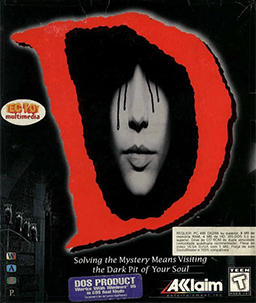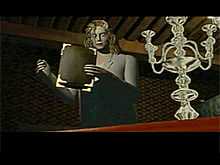D (video game)
| D | |
|---|---|
 | |
| Developer(s) | WARP |
| Publisher(s) | Acclaim Entertainment |
| Director(s) | Kenji Eno |
| Writer(s) | Kenji Eno |
| Series | D |
| Platform(s) | 3DO, Saturn, PlayStation, MS-DOS |
| Release date(s) | 3DO[1] Director's Cut
PlayStation[3] MS-DOS[4] |
| Genre(s) | Survival horror, Puzzle adventure |
| Mode(s) | Single player |
D (Dの食卓 Dī no Shokutaku, lit. "Table of D") is a survival horror puzzle adventure game released in 1995 by WARP.[5][6] The first entry in the D series and one of the first games released by the company, it dealt with taboo content such as violence and cannibalism,[6] featured 3D CGI full-motion video and a first-person perspective,.[5] It was the first game to star the digital actress, Laura.
Characters
Laura Harris: Laura is a scholar in her late twenties at a school in San Francisco. Her father, Dr. Richter Harris, is the director and supervisor of a hospital in Los Angeles. Her mother, the wife of Dr. Harris, was violently killed years ago; she was found stabbed to death with her limbs amputated. Laura’s only keepsake from her deceased mother is a blue compact (which also appears in D2). The mirror holds a power that can show hints of the future and as such, is of great use and value to Laura.
Dr. Richter Harris: Father of Laura Harris. He was the supervisor of a hospital in Los Angeles and is in his late fifties. Years ago, his wife was brutally murdered. He has gone insane and killed a large number of patients and staff at the hospital. He is noted as a quiet and studious man, which makes his killing spree all the more puzzling.
Story
The game begins when Laura Harris is contacted by Los Angeles police, receiving a disturbing message: her father, Dr. Richter Harris, has gone on a mass murdering spree and barricaded himself in the hospital. Laura rushes to the scene of the crime, desperate to find an explanation for the well-respected doctor's actions. Upon entering the hospital, she is so horrified at the murdered bodies lying about the halls that she covers her eyes. When she uncovers them again in the 3DO version, she finds herself in an unknown dark castle. In later versions of the game, she is still in the hospital and explores further, until taken by a small metallic entity to the castle.
Unwilling to give up her search, Laura continues through the dark corridors of the medieval hall. While attempting to find her father, she experiences a series of flashbacks of her mother being stabbed to death. Laura's father (taking the form of apparitions) warns her to leave, saying that staying too long means being stuck in the alternate reality forever. He warns that he will soon become an emotionless monster and will eventually try to kill her. Still shaken, Laura proceeds to find her father residing at the peak tower of the castle. Angrily, the father reveals the sordid past of his family: Laura and her father are part of a bloodline with an insatiable appetite for human flesh, dating back to the infamous Dracula. Laura had killed and eaten her mother years ago, but it was erased from her memory by her father. As Dr. Harris begins to transform into a vampire, Laura has to make a choice: kill or be killed. There are four endings available depending on the players' actions at the end.
Time Elapsed Ending
If the player runs out of time (2 hours), the other world will be closed off, and Laura will be pulled back to the real world.[7] A screen will follow simply saying "Out of Time. Please Try Again."
Bad Ending
If the player approaches Laura's father and doesn't shoot him, the screen will fade to black. The sounds of Laura's father devouring her are heard over the credits.
Good Ending
If Laura fires the revolver that she found earlier in the game before Dr. Richter Harris transforms, the bullet will kill him and stop his transformation. Laura cradles her dying father in her arms as he confesses that he allowed the transformation to occur out of scientific curiosity and thanks her for stopping him. With his death, the realm created by his mind fades and is replaced by the normal surroundings of the hospital. After the credits, a screen will appear suggesting that the player can try the game again in order to see any missed scenes.
Best (100%) Ending
Throughout the game, the player may see scarab beetles in various places. If they view all four of them, they'll receive the 100% ending, which consists of the Good Ending as well as the sound of a baby crying near the end of the credits.
Saving and pausing
An unusual aspect about D is that it offers no options for pausing the game or saving progress, thereby forcing the player to experience the game in real time.
Production

D began production in 1994 for the 3DO console. With use of only three Amiga computers, WARP was able to harness impressive 3D visuals.
Because the storyline and graphic FMVs were more horrifying than any video game that had yet been released, head developer Kenji Eno resorted to a trick in order to get D published. The game was originally developed with no storyline, and Eno kept the story sequences a secret even from the other members of WARP. When the game was finished, he submitted a "clean" version (i.e. without the violent and disturbing story content of the complete version) for approval. He deliberately submitted the master late, knowing that part of the penalty was that he would have to deliver it by hand to the manufacturers in the USA. While on the plane ride to the USA, he switched the phony "clean" discs with the finalized discs, thus completely bypassing all censorship.[6]
Though it sold extremely well in Japan (the Saturn version reached number 1 in the Japanese charts in its first week[8]), D initially failed to make an impact in the US. Nevertheless Acclaim took it upon themselves to not only port D over to the Sega Saturn, PlayStation and MS-DOS, but to localize all three versions to both the USA and Europe.[2][3][4] While most of these releases sold well, Sony failed to manufacture enough units of the PlayStation version to match preorders, resulting in sales of less than a third of what they otherwise would have been. Kenji Eno explained:
When I released D on the PlayStation... the sales people gathered orders for 100,000 units, but Sony had given their other titles manufacturing priority. So Sony told me that they had only manufactured 40,000 units... But then, in the end, they had actually only manufactured only 28,000 units, which is very bad. So the sales people had gotten 100,000 preorders from retailers, but Sony wasn't able to manufacture all of them. I was very pissed about that, because one title like that for a small company is very important. If that game doesn't sell well, then that's very bad for the company...[6]
WARP took revenge on Sony by releasing the games Real Sound: Kaze no Regret and (more famously) Enemy Zero as Sega Saturn exclusives.[6]
There is a very rare edition of D called D's Diner: Director's Cut. It features never before seen sequences, four trailers for the game, a "D" "sound novel" that tells the history of Laura's family, ending as the events in the game unfold and a MiniDisc featuring three tracks from Kenji Eno's D soundtrack on it. Additionally, after completing the game with the "Good" ending and watching the credits roll, players are treated to a long trailer for the original version of D2, which was initially scheduled for the 3DO and later, upgraded for the 3DO M2 Player before being completely reworked for the Sega Dreamcast.
Reception
At the time of release, D was well received. Famicom Tsūshin scored the Sega Saturn version of the game a 32 out of 40.[9] Sega Saturn Magazine scored it an 83%, commenting that the game manages to be extremely creepy and terrifying despite having almost no bloodshed. The reviewer predicted that the game would be outclassed by Resident Evil (still in development at the time of the review), but concluded that D was the best horror game presently on the market.[10] The four reviewers of Electronic Gaming Monthly gave the Saturn version an average of 8 out of 10, commenting that it had reduced the load times seen in the 3DO version to almost nothing. They highly praised the storyline and "intelligently thought-out" puzzles, and described D as "scary enough to make you an insomniac."[11]
In 2008, Game Informer listed the game among the worst horror games of all time.[12]
References
- ↑ 3DO version release data, GameFAQs.com.
- ↑ 2.0 2.1 Release information for Saturn version, GameFAQs.com.
- ↑ 3.0 3.1 Release information for Playstation version, GameFAQs.com.
- ↑ 4.0 4.1 Release information for PC version, GameFAQs.com.
- ↑ 5.0 5.1 Ugur Sener (August 28, 2003). "Game Review". Just Adventure. Retrieved 2011-05-10.
- ↑ 6.0 6.1 6.2 6.3 6.4 "Kenji Eno: Reclusive Japanese Game Creator Breaks His Silence". 1UP.com. 2008-08-07. Retrieved 2008-08-08.
- ↑ "Explanation of Rules", D instruction manual.
- ↑ "D". Sega Saturn Magazine (1) (Emap International Limited). November 1995. p. 19.
- ↑ NEW GAMES CROSS REVIEW: Dの食卓. Weekly Famicom Tsūshin. No.346. Pg.33. 4 August 1995.
- ↑ Hickman, Sam (February 1996). "Review: D's Diner". Sega Saturn Magazine (4) (Emap International Limited). pp. 82–83.
- ↑ "D Review". Electronic Gaming Monthly (81) (EGM Media, LLC). April 1996. p. 33.
- ↑ "The Wrong Kind of Scary: Worst Horror Games Ever", Game Informer (186), October 2008: 121, retrieved 2011-05-10